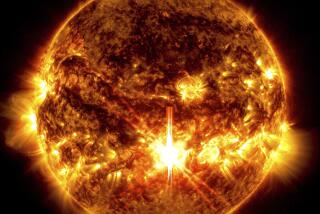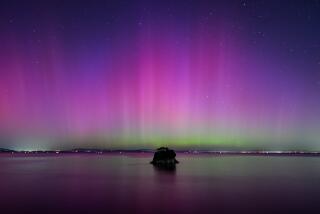Astronauts See Brilliant Southern Lights : Space: The display is caused by radiation from a solar storm. The shuttle crew is not imperiled.
HOUSTON — The fickle Earth, which shook Northern California to its knees Tuesday, put on one of its prettiest faces Friday for five astronauts orbiting the planet.
A brilliant display of the southern lights blazed across the sky as the space shuttle Atlantis sped over Australia.
“This is really spectacular,” Atlantis commander Donald E. Williams told Mission Control at the Johnson Space Center here.
The lights exploded across the entire horizon, dancing and flashing in an exhibition of nature as the ultimate artist.
“It started out mostly green . . . and now it has some oranges and reds and violets,” Williams said. “It almost looks like rain coming down from the universe onto the atmosphere.”
The lights are of more than aesthetic interest to the astronauts. They are caused by high energy particles from the sun striking molecules in Earth’s upper atmosphere, and they are most dramatic when the sun erupts in enormous storms, as it has been for the last few days.
Those solar storms can also knock out communications and affect satellites and spacecraft. But officials at the National Aeronautics and Space Administration said Thursday that they had evaluated the burst of energy and determined that the astronauts aboard Atlantis are not in danger.
Solar storms can cause unstable satellites to tumble from the sky. The shuttle is in a stable orbit, 184 miles above Earth, and the dramatic show posed no threat to the Atlantis or its crew.
NASA officials closely monitor all solar storms to be sure they do not cause any problems for the shuttle. An unusually intense storm, for example, could expose the crew to potentially harmful levels of radiation.
Some recent solar storms have reduced NASA’s chances of rescuing a research satellite the size of a school bus that is threatening to tumble from orbit and crash on Earth. The Long Duration Exposure Facility, as the satellite is known, was to have been retrieved from orbit several years ago, but the explosion of the shuttle Challenger delayed the rescue.
NASA plans to retrieve the satellite by the end of the year, but time is running out, and solar storms reduce the time even further. The storms cause Earth’s lower atmosphere to expand, pushing air molecules to higher elevations, causing a slight drag on the satellite.
By February, NASA scientists believe, the orbit of the Long Duration Exposure Facility will have degraded to the point that it will no longer be safe for the shuttle to come up beneath the satellite, as required for the rescue.
The shuttle is scheduled to land Monday at 12:38 p.m. at Edwards Air Force Base, but several options are being considered because marginal weather conditions have been forecast for the Southern California facility. The winds could be a little higher than NASA prefers, so officials are considering extending the flight a day or two if the weather could be expected to improve.
Alternative landing fields also are being considered.
In addition to Williams, the shuttle’s crew includes Michael J. McCulley, the pilot, Shannon W. Lucid, Franklin R. Chang-Diaz and Ellen S. Baker.
More to Read
Sign up for Essential California
The most important California stories and recommendations in your inbox every morning.
You may occasionally receive promotional content from the Los Angeles Times.










